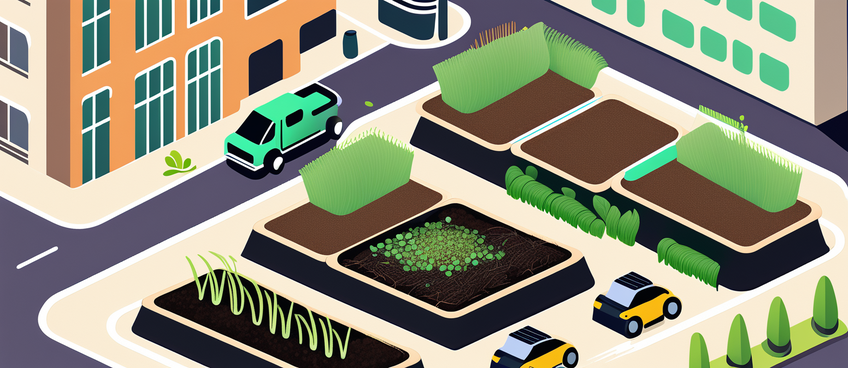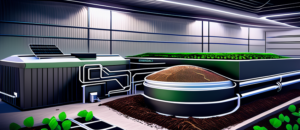Innovations in Composting: Composting, the millennia-old practice of controlled decomposition of organic matter, has surged to the forefront of modern sustainability efforts. With escalating waste issues and climate change’s impending threat, the ecological relevance of this natural recycling process has never been more prominent.
Overview of the Importance of Composting
As the world grapples with burgeoning waste accumulation and a quest for more sustainable living, composting arises as a beacon of hope. It diverts substantial quantities of organic waste from landfills, thereby minimizing the generation of methane, a potent greenhouse gas.
Definition of Composting and Its Environmental Benefits
At its simplest, composting is the biological decomposition of organic material by microbes under controlled conditions. It transforms organic waste into a nutrient-rich soil conditioner, promotes soil biodiversity, mitigates soil erosion, and saves water by enhancing soil structure.
Traditional Composting Techniques
Overview of Traditional Composting Methods
Traditional composting methods have evolved over centuries, heavily reliant on natures blueprint. Practices range from simple heap composting where organic material is stacked outdoors and left to decompose, to intricate techniques that necessitate careful monitoring of moisture, aeration, and temperature.
Importance of Organic Waste Management
Organic waste management, notably through composting, is essential in achieving sustainability goals. It mitigates landfill pressure, reduces greenhouse gas emissions, and provides a natural, chemical-free alternative for soil nourishment.
Examples of Traditional Composting Techniques
Traditional composting techniques, such as backyard composting and vermiculture, employ a low-tech approach. Backyard composting is essentially turning kitchen and yard waste into compost piles, while vermiculture involves the use of earthworms to enhance the decomposition process.
Advancements in Composting Technologies
High-Tech Composting Systems
Introduction to High-Tech Composting Systems
In the race towards efficiency, high-tech composting systems have come to the fore. These systems harness sophisticated technology to expedite the composting process, maintain optimal conditions, and handle vast volumes of organic waste.
Benefits of High-Tech Composting
High-tech composting systems offer enhanced process control, reducing the time required for compost maturation. They can handle diverse waste streams, minimize odor, and are less labor-intensive.
Aerated Static Pile Systems
Aerated static pile systems introduce forced air into compost piles, enhancing microbial activity and accelerating decomposition. The piles, typically composed of yard waste or similar materials, are placed over a network of pipes that deliver air into the compost.
In-Vessel Composting Systems
In-vessel composting systems confine the composting materials within a building, container, or vessel, offering excellent control over temperature, moisture, and aeration. They’re well-suited for composting large volumes of waste with minimal space and odor control.
Advantages and Challenges of High-Tech Composting Systems
While these systems deliver efficiency and rapid processing, they come with challenges, notably high initial investment and operational costs, and the requirement for technical expertise.
Bokashi Composting
Introduction to Bokashi Composting
Bokashi composting, a Japanese innovation, employs a unique approach by fermenting organic waste in a sealed bucket using a specialized inoculant.
How Bokashi Composting Works
In this method, kitchen waste is layered with Bokashi bran, a mix of microorganisms, and sealed. The anaerobic fermentation process that ensues breaks down the waste, resulting in nutrient-dense compost.
Benefits of Bokashi Composting
Bokashi composting is swift, odorless, and can handle diverse organic waste, including items traditionally considered non-compostable, like meat and dairy products.
Differences Between Bokashi and Traditional Composting
Unlike traditional composting, Bokashi composting doesn’t involve heat generation and decomposition. Instead, it uses fermentation, allowing it to process waste in an anaerobic environment.
Composting with Black Soldier Flies
Introduction to Black Soldier Flies (BSF)
Black Soldier Flies, a composting marvel, are nature’s tiny soldiers battling waste. BSF larvae consume organic waste voraciously, leaving behind rich compost.
Life Cycle and Behavior of BSF
The lifecycle of BSF involves egg, larva, pupa, and adult stages. It’s the larvae, with their remarkable ability to devour organic waste, that are utilized in composting.
Role of BSF Composting
In BSF composting, the larvae consume the organic waste, converting it into biomass and nutrient-rich frass (larvae waste), an excellent soil amendment.
Benefits of Composting with BSF
Composting with BSF is efficient, reduces the composting period, and is particularly effective in managing food waste.
Applications of BSF Composting
BSF composting finds applications in residential waste management, small-scale farming, and industrial waste processing.
Industrial-Scale Composting
Overview of Industrial-Scale Composting Facilities
Industrial-scale composting facilities are large-scale operations that process significant volumes of waste. They employ various composting technologies to manage waste from municipalities, industries, and agriculture.
Large-Scale Composting Processes and Techniques
Techniques used in large-scale composting include windrow composting, where organic waste is placed in long rows and regularly turned, and aerated static pile composting, among others.
Benefits and Challenges of Industrial-Scale Composting
While these facilities significantly contribute to waste reduction and produce vast amounts of compost, they face challenges such as odor control, high operational costs, and regulatory requirements.
Examples of Successful Industrial-Scale Composting Projects
Success stories include the Cedar Grove Composting facility in Washington State, USA, and the Surrey Biofuel Facility in Canada, which process thousands of tons of waste annually.
Innovations in Composting Materials
Composting Bio Plastics
Introduction to Compostable Bio Plastics
Compostable bio plastics, made from plant materials, have emerged as a solution to plastic waste. These are designed to decompose in composting conditions.
How Compostable Bio Plastics Break Down in Composting
In composting environments, microorganisms break down these bio plastics, turning them into water, carbon dioxide, and biomass, leaving no toxic residue.
Advantages of Composting Bio Plastics
Composting bio plastics can decrease plastic pollution and reduce reliance on fossil fuels for plastic production.
Challenges and Considerations in Composting Bio Plastics
However, composting bio plastics require specific conditions to break down completely, which are not available in most home composting systems.
Composting Food Waste
Importance of Diverting Food Waste from Landfills
Food waste is a significant contributor to landfills and methane emissions. Composting provides an effective strategy to divert food waste, converting it into a valuable resource.
Innovative Techniques for Composting Food Waste
From Bokashi composting to anaerobic digestion, innovative techniques have emerged for composting food waste, each providing unique benefits.
Anaerobic Digestion for Food Waste Composting
Anaerobic digestion, involving the breakdown of waste by bacteria in an oxygen-free environment, produces biogas (a renewable energy source) and nutrient-rich digestate, a valuable soil conditioner.
Benefits and Limitations of Food Waste Composting
While food waste composting contributes to waste reduction and nutrient recycling, challenges include odor management, the presence of contaminants, and the requirement for segregation of compostable materials.
Composting Human Waste
Overview of Composting Human Waste (Ecosanitation)
Ecosanitation, the practice of composting human waste, can address sanitation issues, particularly in resource-poor settings, while also creating a valuable soil amendment.
Benefits of Composting Human Waste
Composting human waste reduces water pollution, conserves water, and provides a locally sourced nutrient-rich compost.
Challenges and Considerations in Composting Human Waste
However, it involves overcoming cultural and social barriers, ensuring pathogen destruction, and adhering to regulations to ensure safe use.
Success Stories of Human Waste Composting Projects
Positive examples include SOIL in Haiti, which collects and composts human waste, transforming it into organic, agricultural-grade compost.
Applications of Compost
Compost in Agriculture
Importance of Compost in Sustainable Agriculture
Compost is a linchpin in sustainable agriculture, replenishing soil fertility, improving soil structure, and reducing reliance on chemical fertilizers.
Benefits of Using Compost in Farming
Compost provides a slow-release source of nutrients, enhances soil water retention, and fosters beneficial soil organisms.
Compost as a Soil Amendment and Fertilizer
As a soil amendment, compost improves soil structure, texture, and aeration, and as a fertilizer, it provides a spectrum of essential nutrients for plant growth.
Case Studies of Successful Compost Applications in Agriculture
Rodale Institute’s Farming Systems Trial is a testament to compost’s role in improving crop yields and soil health.
Compost in Landscaping and Gardening
Benefits of Using Compost in Landscaping and Gardening
In landscaping and gardening, compost nourishes the soil, enhances plant health, reduces the need for water and chemical fertilizers, and aids in pest control.
Improving Soil Health with Compost
Compost enriches the soil with organic matter, promotes the proliferation of beneficial microorganisms, and buffers soil pH, fostering a vibrant soil ecosystem.
Compost as a Natural Weed Suppressant
Applied as mulch, compost can suppress weed growth, reducing the need for labor-intensive weeding or harmful herbicides.
Tips for Using Compost in Home Gardens and Landscapes
Appropriate compost use involves integrating it into garden soil, applying it as mulch, or making compost tea as a nutrient-rich, liquid fertilizer.
Compost in Urban Environments
Urban Composting Initiatives and Programs
Urban composting initiatives, such as community composting programs and curbside compost pick-up services, have emerged, empowering city-dwellers to contribute to waste reduction.
Benefits of Composting in Urban Areas
Urban composting reduces the pressure on municipal waste management, decreases transportation emissions related to waste hauling, and generates compost for city green spaces.
Community Gardens and Urban Farming with Compost
Compost enriches urban community gardens and urban farms, enhancing crop productivity, and fostering local food production.
Urban Composting Challenges and Solutions
While space constraints and lack of awareness pose challenges, solutions include efficient composting systems like vermicomposting and Bokashi, and public education about composting benefits.
Future Directions and Innovations
Emerging Trends in Composting Technologies
Emerging trends in composting technologies include smart composting systems with automated controls and monitoring, and novel composting materials like biochar.
Potential Developments in Composting Practices
Advancements in microbial studies may refine our understanding of the composting process and lead to more efficient practices.
Integration of Technology and Composting
The integration of technology, such as the Internet of Things (IoT), can optimize composting through real-time data on composting conditions, leading to better process control.
The Role of Composting in Circular Economy Models
Composting plays a significant role in circular economy models, where waste is viewed not as an end product but a resource, closing the loop in nutrient cycles.
Conclusion of Innovations in Composting
Recap of Recent Trends and Developments in Composting
The composting landscape is evolving, with novel techniques, materials, and applications continuously emerging. From high-tech composting systems to composting bio plastics, innovation permeates every aspect of composting.
The Importance of Embracing Innovative Composting Methods
Embracing innovative composting methods is paramount in the journey towards sustainability. It not only addresses waste issues but also cultivates healthier soils, sequesters carbon, and contributes to a resilient food system.
Encouragement for Readers to Explore Composting Options
The future of composting is teeming with promise. It beckons us all to explore, participate, and tap into the transformative power of this humble natural process in our quest for a sustainable tomorrow.
FAQs
Q: What is compost versus fertilizer?
A: Compost and fertilizer boost soil productivity differently. Organic compost improves soil structure, water-holding capacity, and biological activity. It contains many nutrients in lower amounts. Fertilizer, on the other hand, only provides nitrogen, phosphorus, and potassium in large amounts and doesn’t improve soil structure or fertility.
Q: Is all kitchen waste compostable?
A: Some kitchen waste cannot be composted. Compost vegetable and fruit scraps, coffee grounds, and eggshells. Meat, fish, dairy, and oily or greasy food waste attract pests and smell bad. Bokashi composting may not have these restrictions.
Is compost turning necessary?
A: Turning your compost pile aerates it, encouraging aerobic bacteria to decompose organic material. Turning speeds up and uniformizes composting, but it’s not necessary. Turning isn’t needed with Bokashi or vermicomposting.
Q: How do I fix a stinky compost pile?
A: A lack of aeration, an imbalance in green (nitrogen-rich) and brown (carbon-rich) materials, or the presence of meats or oils may cause your compost pile to smell. Turn the compost to add air and check the balance, adding brown materials if needed.
Composting takes how long?
A: Composting times vary depending on the method, materials, and weather. Compost takes 212 months to mature. High-tech composting systems like Bokashi can produce compost in weeks.
Our Reader’s Queries
What are the new innovations in composting?
A new composting technology that’s gaining popularity is the Aerated Static Pile with Reversing Air and Biofilters. This system uses reversing air technology to periodically bring in fresh air to aid in aerobic decomposition, while simultaneously expelling odorous gases through a biofilter. This innovative approach ensures that the composting process is efficient and effective, while also minimizing unpleasant odors.
What are some innovative composting methods?
New and innovative composting techniques like membrane-covered aerobic composting and vermicomposting have been found to be more effective than traditional methods in enhancing soil biodiversity and boosting plant growth. Studies conducted by Sun et al. in 2018 and Xiong et al. in 2022 have shown promising results in this regard. By adopting these unconventional methods, we can not only improve the health of our soil but also contribute towards a greener and more sustainable future.
What are the new methods of composting?
Vermicomposting, also known as worm composting, is a process that utilizes earthworms and microorganisms to transform organic materials into worm castings, which is a top-notch soil amendment. This system can be set up indoors or outdoors, in a shaded area, and can be customized to match the amount of food scraps being added to the system. With vermicomposting, you can easily create a high-quality soil amendment that will help your plants thrive.
How can composting be improved?
Accelerating the composting process is easy with a few simple steps. Firstly, create a larger pile of organic waste to generate heat, which is essential for nutrient-rich fertiliser production. Secondly, maintain the right balance of brown and green materials. Thirdly, shred everything to speed up the decomposition process. Fourthly, turn your pile over and aerate it to allow oxygen to circulate. Lastly, keep your pile moist to ensure the composting process is not hindered. By following these tips, you can create compost quickly and efficiently.



